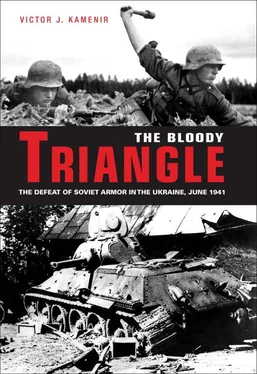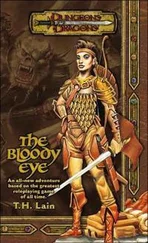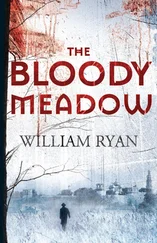South of them, aimed at Sokal, the LV Corps of Sixth Army was echeloned in front of XLVIII Mechanized Corps of Panzer Group 1, with the XLIV Corps farther south. Finally, in reserve of Army Group South, located in the area of Lyublin, was the XIV Motorized Corps.
The German units were deployed in very compact, concentrated formations, achieving density of one division per three miles of front. Compared to up to thirty miles of frontage occupied by some Soviet divisions along the border, the Germans were well-positioned to penetrate porous Soviet defenses by bringing the maximum amount of forces at the place and time of their choosing. Still, von Rundstedt and his senior commanders clearly understood the complexity of launching a major invasion with the northern wing alone, as underscored by command staff exercises in Saint Germain, France, in early February 1941:
It shows the difficulty of accomplishing an enveloping operation west of the Dnepr [Dneiper], with the northern wing alone, particularly in view of the possibility that this wing might be threatened or at least slowed in its advance by enemy attacking from Pripet area…. [4] Halder, 316.
By any attack against the Russian army, one must avoid the danger of simply pushing the Russians back. We must use attack methods which cut up the Russian army and allow its destruction in pockets. A starting position must be created which allows the use of major envelopment operations. [5] Ibid., 297.
It is common nowadays to lambaste German military planners for underestimating Soviet military capabilities. The often-quoted Heinz Guderian, godfather of German panzer operations, estimated the Soviet tank park at over ten thousand in 1937, knowing that these numbers would only grow yearly at an ever-increasing pace. In 1933 he visited one tank factory in the Soviet Union, producing twenty-two tanks a day. [6] Guderian, 144.
Extrapolating from this figure and allowing for a modest five-day week, fifty-two weeks per year, these numbers amount to an output of 5,720 tanks per year. And these numbers are just for one factory in 1933. Doubtless, the German planners made projections of what the Soviet tank strength would be in 1941. In a similar vein, a Luftwaffe officer, Maj. Rudolf Loytved-Hardegg, tasked with preparing intelligence estimates about the Red Air Force, placed the number of Soviet combat-ready aircraft at fourteen thousand. [7] Stolfi, 19.
The two men were echoed by Halder:
Comments on Russian tanks: Redoubtable; 4.7cm gun (AT) a good medium weapon; bulk of tanks obsolete. Numerically Russia’s tank strength is superior to that of any other nation, but they have only a small number of new giant types with long 10cm guns (mammoth models, 42 to 45 tons). Air force very large in number, but mostly outdated; only small number of modern models.” [8] Halder, 345.
This mention about the “new giant types” of tanks dispels the notion that Germans were unaware of the new generation of large Soviet tanks. However, this particular entry was not clear to which model Halder was referring; KV-1 armed with a long gun but 76mm in caliber, or KV-2, which was armed with a heavier but shorter 152mm howitzer.
Despite being contemptuous of Soviet combat capabilities and leadership, the German planners were wary of the sheer numerical enormity of their future opponent. Underscoring that it would be a giant undertaking to topple the Soviet colossus, a terse entry in Halder’s famous war diary on January 28, 1941, read: “Commit all available units.” [9] Ibid., 314.
It appears that Hitler himself placed his support behind the best possible chances of success: “AAA (Anti-Air Artillery). Führer wants no serviceable piece to remain inactive. Personnel for thirty batteries. AAA Corps, of six battalions, for Sixth Army (Panzer Group 1) and Panzer Group 2.” [10] Ibid., 324.
Nor were logistics underestimated; another entry on the same day: “Satisfaction is possible only when the point of main effort is prepared through the collaboration of all forces in order to solve the most significant supply issues concerning transportation, tires, fuel, and storage. The air force and army must use the available transportation through careful, coordinated effort.”
Halder comments on the sheer size of the Soviet state:
Problems of Russia’s vastness: Enormous expanse requires concentration of critical points. Massed planes and tanks must be brought to bear on strategic points. Our air force cannot cover this entire huge area at one time; at the start of the campaign, it will be able to dominate only parts of the enormous front. [11] Ibid., 345.
Immensely hampering German planning efforts was the closed nature of the Soviet society. Tourism by private western citizens into the Soviet Union was practically at zero, virtually negating German efforts to explore the Soviet defensive and industrial capabilities lying in the hinterland of the vast country. Even the most basic building block of any planning, maps, was in short supply: “Difficulty with Russian maps. Especially the tactical maps (1:100,000) are very poor. Lower echelons must be warned on how staff work will be affected by such bad maps.” [12] Ibid., 318.
However, the new territories which Soviet Union acquired after the 1939 partition of Poland contained large numbers of locals either sympathetic to Germans or hostile to the Soviets, providing German intelligence with accurate tactical information about the border areas.
Overall, German planners were well aware of the effects Stalin’s purges had on condition, capabilities, and morale of Soviet military in general and its officer corps in particular. German intelligence rightly determined the Soviet command and support structures to be slow to respond, bulky, cumbersome, and not ready to adapt to rapidly changing tactical situations.
The striking power of Army Group South rested with its five panzer divisions, all veteran formations. Impressed with the performance of armored units in 1939 and 1940, Hitler ordered the number of panzer divisions doubled from twelve to twenty-four for the 1941 campaign. However, this increase in numbers of divisions was not matched by a proportionate increase of total number of tanks. In 1940, the maneuver portion of a panzer division was composed of two panzer regiments and one motorized infantry regiment. The doubling of panzer divisions was achieved by shuffling the balance of regiments within a division. The 1941 panzer division had one panzer regiment with two motorized infantry regiments.
Suffering from chronic shortages of raw materials, production capacity, and availability of specialist workers, the German armament industry was not able to deliver the number of tanks required for twenty-four panzer divisions. While a panzer division of 1940 numbered close to 300 tanks, the start of the campaign against the Soviet Union in 1941 saw German panzer divisions numbering less than 160 tanks each. [13] Based on a two-battalion regiment. Nine panzer regiments had three battalions, none of them belonging to Army Group South.
The table below is based on A. V. Isayev’s book, in turn quoting Thomas Jents: [14] Isayev, 73.
Table 1.
Tank Strength of Panzer Group 1

In addition, there were two battalions of assault guns and two more of tank destroyers assigned to Panzer Group 1, numbering approximately 180 more armored vehicles.
Читать дальше






![О Генри - Социальный треугольник [The Social Triangle]](/books/405340/o-genri-socialnyj-treugolnik-the-social-triangl-thumb.webp)






